It’s no big news that Chinese market is growing with an impressive speed and more and more businesses turn eastwards – both for production and marketing. Over a billion people live inside the Far East giant borders – a healthy reason to address the region in order to increase sales as well as exposure.
The news is, however, that the internet content is now also part of the trend. China has reportedly surpassed USA in the number of internet users in mid-2009, and although English is still the primary internet language (42 percent of almost two billion of online “population” worldwide), Chinese is in solid second place, with about 32 percent. And since China is still less technologically advanced than the Western Countries, the number of potential Chinese speakers, who will soon be joining the online world is far greater than that of the English language carriers.
And with the Chinese government now requiring all English content in China-based websites to be accompanied with local Mandarin translation, the number of webpages in Chinese is about to increase immensely. And, restating the above thought about more and more companies regarding China as a prospective market, it seems that the near future of online marketing can easily shift toward Chinese content.
I am sure many people out there have tried to get included in Google News. We have been successful in getting multiple websites included in Google news. Recently we have been working fairly hard to get busy blogging. We decided to attempt to get SEO Moves included in Google news. Just for fun I am going to include the thread of conversation I have had with the people at Google News:
#1- Request Inclusion to Google News
#2- wait……
#3- Google News Replied:
“Hi john,
Thank you for your note.
We reviewed your site and are unable to include it in Google News at this time. We currently only include sites with news articles that provide timely reporting on recent events. This means we don’t include informational and how-to articles, classified ads, job postings, fictitious content, event announcements or advice columns.”
#4- SEO Moves Reply Back:
“Hi Google,
In looking at a search today for search engine optimization- the results include a bunch of posts from ZDnet (screen capture included). These posts are really along the lines of what we post, but written by one man who proclaims himself to “NOT” be an SEO expert?
I wish you would reconsider our inclusion as we are really giving people strong real time advice, and tips. 100% white hat information and we are working hard to help the small and medium size businesses succeed online.”
#5- Google News Reply:
“Hi John,
Thank you for your reply and for providing us with this additional information about your site. As we previously mentioned, the articles in Google News report on recent events. We currently don’t include informational and how-to articles, classified ads, fictitious content, job postings, event announcements, or advice columns.
Thanks for your interest in Google News.
Regards, The Google News Team”
Lets Take look at Google News Today for fun:

If you’re not using video on your website, you should be. Any business can use video on their website to improve their branding and profits. In fact, small businesses have been quick to adopt video on their websites. The number of small businesses using video on their websites at the end of 2009 was four times as great as only one year earlier. Video capability was the single fastest growing feature small businesses added to their websites. On-page video is one of the best known ways to engage an audience and it’s also a way to position your business right in front of those who are seeking out your product or service using search engines.
You can use video to showcase how to use a product, to show testimonials, to highlight a product’s features, or to upload clips made by customers about the product. Since search engines used to have to ignore video, everyone pretty much dismissed video. But now Google’s universal search format, which includes videos, news, blogs, maps, and other so-called vertical search content is making video more relevant than ever. Another factor driving the importance of video in SEO is the increasing saturation of broadband internet coverage. And there’s the simple fact that people like watching short videos. We’ve all watched funny cat or “fail” videos on our coffee break. Given all this, it makes sense to do what you can to optimize video content for search engines.
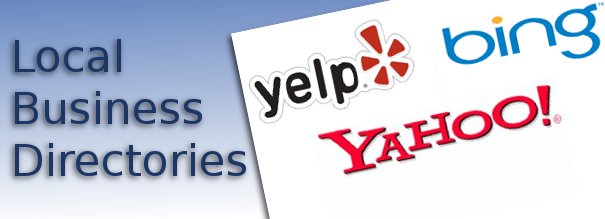
Local internet business directories can help your business out locally. While you may consider your business to be web-wide, there’s nothing wrong with getting the support of the local population, particularly if your business has a bricks and mortar presence too. Even if you do all your work over the web (such as translating documents or writing software apps), there’s no telling who might be living in the same area as you who needs exactly the skills your business offers. Don’t miss out on local attention thinking that just being on the web will catch everyone. It doesn’t take long to sign on to local business directories, and in most cases it’s free. Three local directories you should check out are Yelp, Yahoo! Local, and Bing Local.
Isn’t it a rush to get positive feedback about your business? Well, those compliments can be used to your advantage if you use them wisely. The goal is to not only get compliments, but also get real recommendations that other potential customers can see. That’s why local directories like Yelp are so helpful. yelp.com lets you gather good reviews about your company from customers. It is easy to get started.
First, register your business on Yelp by using its business profile directory. You can do this for free at https://biz.yelp.com/signup (see screen shot). The next thing to do – and this is important – is to review other companies and services you’ve used yourself, whether it’s a mechanic, a veterinarian, a restaurant, or some other local business. Keep your reviews positive, which means only reviewing businesses about which you feel positive. If you appear troll-like, you wont’ gain any credibility.
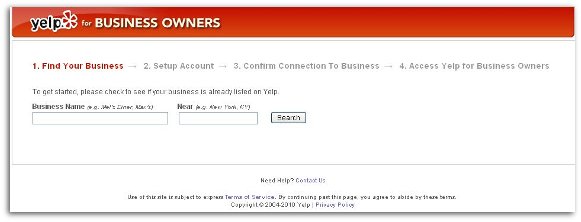
The next thing to do is to invite colleagues and friends to comment on and review your business. You don’t want a flood of these to come in at once. Yelp dislikes spam, and may construe a dozen glowing reviews your first day as such. Another thing you can do is ask your reviewers to review other local businesses as well so Yelp doesn’t think you’re coercing people.
You should build a good profile on Yelp, and you need to stay active in your community by reviewing other businesses (Many will reciprocate.) and make your listing more than just a boring list of your services and business hours. Let all your customers know that you’re on Yelp and that you’d appreciate a review. This is a good thing to include in your business’s email newsletter if you have one. The more you use Yelp’s social networking features, the wider a group of people you’ll connect with, boosting your presence on Yelp even more.
Claiming your Yahoo! Local profile will expose your business to local clients, and you can use the same information and photos that you use on Google Local (if you have it). You can edit your Yahoo! listing any time with changes to business contact information, business hours, and other important information. You can, if you choose, invest in a local enhanced listing. This lets you add to the basic listing your company logo / tagline, up to 10 photos, a more detailed business description, two customizable links for coupons, inclusion in up to 5 categories. You can check out the kind of things you get from an enhanced listing from the screen shot.
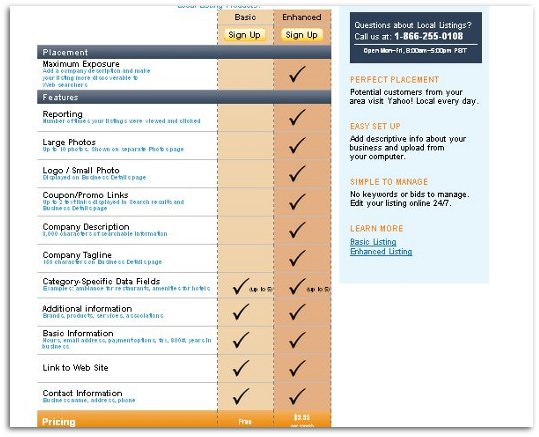
But even the free listing will bring more business your way. Yahoo! Local only lists businesses that serve designated geographic locations in the U.S., so if you’re online-only or statewide, then you can’t list there. You can improve your chances of your listing being accepted by carefully reading the basic listing requirements first and follow them. Assuming you are able to list there, ensure that the name of your business and your contact information is shown on every page of your website. If you don’t have a bricks and mortar store, clearly show how potential customers can make an appointment with you. Keep in mind that it may take up to five ddays for your listing to show up on Yahoo! Local, so don’t resubmit your site if it hasn’t been at least five days. You can check on the status of your listing on the Yahoo! Local Listings website.
Setting up your local listing on Bing is easy and it’s free. The first thing to do is to go to the Bing Local Listing Center, where you can create a local listing. When you start creating your account, Bing asks you for your Windows ID. If you don’t have one, you’ll have to create one, or you can create one by going to this link before setting up your listing on Bing. You’ll have to enter contact and business info, additional phone numbers, email addresses, hours, etc. You’ll also get to fill out a long section for information like your company’s tagline, brands, affiliations, and a bunch of other things. Try to fill in as many fields as possible, because it’s to your benefit.
You can then choose up to six categories in which to place your business based on your associated keywords. Bing has good local search refinement, so you want to take advantage of this by choosing as many categories as you can. After you finish this, you’ll have to review your business listing and check that the push pin locator is correct. If so, submit it and you’re done.
You might think that these local directories don’t make much of a difference, but you’d be surprised. Having complete listings on all the local search providers is good for your business and gives your local customers (and potential customers) another way to find you. Setting up accounts on Yelp, Yahoo! Local, and Bing Local does not take very long at all, and it’s a great way to point more people toward your business.

If you’ve read this blog for any length of time, you might be scratching your head and saying, “What?”
We’ve come down hard on link exchanges for the purpose of building your Google PageRank or search engine standing, and there’s good reason for it. It started out as a way to cheat to get to the top. You give some links, and you get some back. It sounds harmless, and when done “organically” it’s not just harmless, it’s a great way to boost your position in the search engine rank pages (SERPs). Say you run a blog about motorcycle gear and you’ve been at it for awhile, so you’ve built up some history. You might find some of the site you wish would link to you (but that may never know you exist) and simply ask if they would link to your site. Quite often the answer is “yes.” Most legitimate websites have enough good will that they’ll give a promising newcomer a little help.
However, in between the link farms, which are created solely to increase back links regardless of relevancy or reputation, and doing it the old fashioned way by asking sites to link to you, there are some programs that walk a middle path. They may have a legitimate website where site owners can categorize their site and find other sites that are about the same (or nearly the same) topic. For example, such a site might have a category for cooking blogs and another category for political blogs, another for sites on antique book appraising, and a bunch more categories.
The idea is that each day you’ll go to your category or one that’s closely related, look at several sites, and click a button that gives that site some link love by placing a link to it. And every day a bunch of other sites in your niche will do the same thing and hopefully leave you some back links in exchange.
Is this “cheating”? Will search engines penalize you for this?
It’s hard to say.
In the screen shot you can see part of Google’s Webmaster guidelines that kind of / sort of address this. Clearly, exchanging links for the sake of links regardless of relevancy or quality is not good. Google will penalize your site for this.
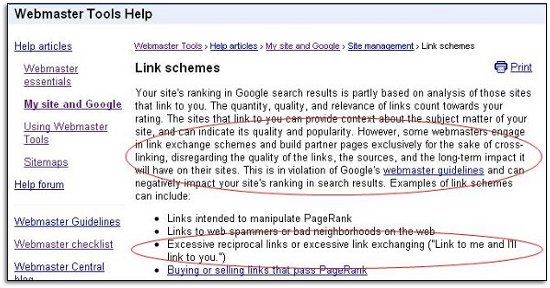
On the other hand, it says that “link schemes” can damage your standing and include among “link schemes”
Excessive reciprocal links or excessive link exchanging (“Link to me and I’ll link to you.”)
The important word in that statement is “excessive.” How do you define “excessive”?
One way that link exchanges may seem excessive has less to do with their sheer numbers and more to do with their relevancy. If you run a site about organic gardening and exchange links with a couple of, ahem, “adult entertainment” blogs, you’re doing much more harm than good.
If, however, you participate in a link exchange with a relevant category and you find a few sites that you wouldn’t have found otherwise, that are good fits for your site as far as relevancy and quality, then there’s no real problem. If you had found those sites organically, you probably would have asked for links from them anyway. You just had a little help finding them.
Look at it this way: If Google gave no influence to back links, either good or bad, or if Google didn’t exist, would you link to those sites and ask for links to yours? Or alternatively, would you link to those sites even if you had no idea if they would link to you? If the answer is yes, then you’re probably OK.
If you run a site and you have, say three hours a day you devote to research and / or link building (I wish!) then you probably shouldn’t devote more than one of those hours to participating in a targeted link exchange. Spend the other two working on other off-page optimization like searching out new sites to evaluate and possibly ask for back links. That way you won’t risk an explosion in link numbers that would tip off the search engine gods and make them think you’re up to some illegitimate link-swapping.
When you find a relevant site that you really like, and you read it and are convinced it would be a good back link to have, asking directly for that back link means a lot more than the three or four links you might get on an “I’ll link to you if you link to me” site. For one thing, it’s great to get that vote of confidence when someone likes your site enough to ask for a link. The first time some cool site contacts you to ask for a back link is a milestone of sorts.
And another thing to consider is this: how many high quality sites do you know of that have link exchange “badges” – particularly above the fold – that indicate their participation in link exchange sites? Not many, I’d bet. While they’re not exactly signs of desperation, they show exactly what you’re up to, and indicate that maybe you can’t get back links any other way. Fair? Of course not. But that’s the reality you have to deal with.
Link farms and paid link exchanges really will harm your site, no question. Targeted link exchange programs where you give and ask for links based on relevancy and perceived quality can be OK, as long as you don’t depend “excessively” on these sites for links.
Even with embedded video, flash, and other non-text content, the internet is still mostly made up of information in text form. Search engines that crawl the web looking for good sites with high quality content are crawling text. They can’t “see” images, so any information they get pertaining to those images have to come from filenames and from the text surrounding the images. Pages without text won’t rank well. Pages that have text have an advantage that depends partly upon how relevant and cohesive it is. The best content, according to the search engine crawlers, is text that is keyword rich (not stuffed), original, and relevant. Using article directories is a strategy to boost the search engine rankings of your website and hence your sales.
Article directories allow anyone to post articles for marketing. The articles have to be informative and can’t just be blatant sales pitches. Most article directories have fairly strict rules on the standards that the articles they publish have to meet. Many times these rules relate to the number of “self-serving” links allowed in the main body of the text, and the information that can be placed in the “resource box” that is placed at the end of each article.
Put simply, article directories are a way to spread the gospel about your website. If you adhere to the rules set forth by an article directory, you’ll have no problem getting your articles accepted. Google likes the major article directories, like Ezinearticles, ArticlesBase,and Goarticles. An article in one or all of these directories can get you some nice back links to your website. In fact, you’ll have a better chance of ranking on the first page of search engine results with articles on one of these sites than if the article was on your own website.
As far as back links go, back links from some article directories are more valuable than back links on others. But since the number of back links your website has is taken into account (as far as we know), then you should benefit from them. The “bad” back links are ones from paid link schemes, link swapping schemes, and from the so-called bad neighborhoods on the net, like porn sites and gambling sites.
While you can access services that submit articles to many directories, this isn’t the best idea. For one thing, duplicate articles all over the place aren’t going to get much love from the search engines (since they like original and not duplicated content). And for another, five high quality articles submitted to five high quality article directories will benefit you more than two dozen crappy articles submitted everywhere in a scatter-shot approach. The top article directories are high traffic sites, and some of that traffic is bound to find your site from your bio or resource box.
Before you write an article for a given directory, go to their submission guidelines and make sure you follow them. Some are more strict than others. Ezinearticles, for example, is very strict about the number of links that can go in articles, how far into the article those links must appear, and whether or not those links appear “self-serving.” (See screen shot of Ezinearticles editorial rules) Other sites, however, like eHow and GoArticles.com are not as picky. But they have their rules too, and you have to follow them.
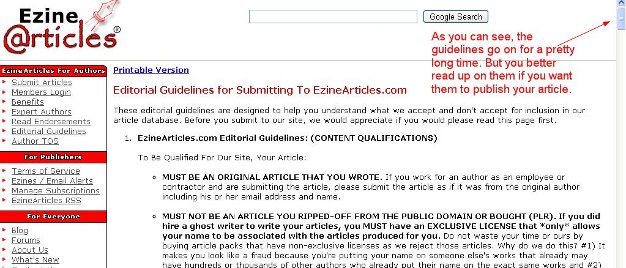
On most sites, you can freely submit articles once you register a free account. You’ll generally be able to add an author byline, a hyperlink, and the address for your website. The better written the article is, the more readers it will attract, and the more potential traffic your website could receive.
After you have your accounts set up, you should do some keyword research to see which keywords you need to target with your articles. If you can write (or have somebody write) several unique articles targeting those keywords, you can potentially draw a lot of attention to your site indirectly. Choose your titles carefully. Sometimes this can be tricky, because you have to worry about duplicate titles, but really give it the thought and attention it deserves. Keywords in your titles are important, just like they are on your website.
While article directories don’t get as much love as they used to from search engines, they still get points for original, keyword relevant content, and the best article directories are still good sources of back links to your site. It is still not unusual for articles from the top article directories to rank on the first page of the search engine results for some topics. It is about as close as your site can get to free advertising, even if you have to hire a writer for the articles.
Create a bio for yourself as the author (even if you outsource the writing, you’re the one who ends up with the copyright). Most article directories allow at least one link to be placed in the “bio” box. Sort out how many self-serving links you get, and then sort out how you want to parcel them out between your website’s home page, other pages on your website, or your blog if you have one.
Link to your article directory submissions from your blog and from social networking sites like Facebook and Twitter. You can also use sites like Digg and StumbleUpon to bring a few more eyeballs to your article.
In conclusion, article directories are another tool in your web promotion toolkit. They are about as close to free advertising as you can get, and if your content is good, you will be rewarded for it with increased traffic to your site.
Update, I have had several requests for a list of article directories, so here is some we use:
http://www.ezinearticles.com
http://www.ehow.com
http://www.ezarticleinformation.com
http://www.articledashboard.com
Before you hire an SEO (search engine optimization) company or consultant, or a PPC (pay-per-click) company, you should be thoroughly familiar with what they do.
Hiring an SEO company can potentially raise your site’s profile dramatically in a short time, but if they go about it in the wrong way, you risk damaging your site’s standing in the search engines and your business’s reputation. The general things that SEO companies do include:
Perhaps the best time to hire an SEO company is when you’re launching a new site or redesigning an existing site. When you interview SEO companies that you might consider hiring, ask the following questions:
When choosing a site, make sure you understand exactly where the money is going. There are search engines out there that combine paid results with organic results and some SEOs may promise to get you highly ranked in search engines by placing you in the ad section. These companies are not helpful. Who’s to say they don’t create their own “search engine” that they can easily game or control? You care about the big search engines: Google, Yahoo, Bing, etc.
Some SEO companies will create shadow domains that shunt users to a site deceptively. Suppose you complain about their service. They could easily point your domain to a different site or a competitor’s site. Another bad practice to watch out for is creation of doorway pages stuffed full of keywords on the client’s site, claiming they will make the site “more relevant.” Number one, that’s bull, and two, these doorway pages may well contain links to the SEO’s other clients, diluting the popularity of your site and possible rerouting it to illegal or “bad neighborhood” (“adult”) sites.
Run away from SEOs that own shadow domains, that don’t differentiate between organic search results and paid ads on the results pages, who operate with multiple aliases, or who get traffic from fake search engines.
A great place to start when thinking about hiring an SEO company is Google’s Webmaster Central page where you can download a free SEO starter guide (see screen shot). If you’re going to hire an SEO consultant, you should know what they’re supposed to be doing so you can protect yourself from shady practices.
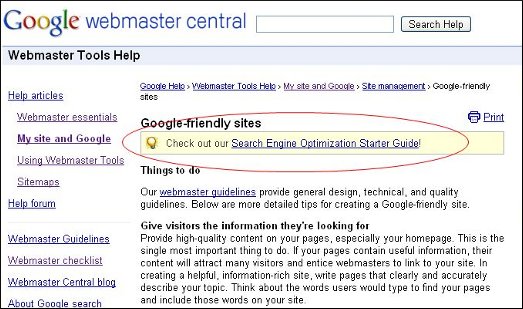
When you choose a PPC company, make sure it doesn’t work for your competitors too. In fact, you should get a guarantee from them that they will not communicate with your competitors when your PPC campaign is in the planning and execution stages. If your PPC company uses unfair means like cloaking to get you a higher rank, fire them at once. They could easily get you penalized or banned by publishers. You should find out what their track record is with top search engines. If their successes come from third-tier engines, look elsewhere for a PPC company. And you should definitely demand references and check up on them.
The reason people hire PPC firms is to give an e-business instant exposure and funnel heavy web traffic to its site. One service provided by PPC advertising firms is landing page optimization. They should also use the marketing techniques that have been proven to increase search engine ranking by honest and acceptable methods. They should increase traffic and conversion rates, and analyze on-site activity as well.
Your PPC company should have a great track record running campaigns on big PPC advertisers like Yahoo and Google. the best PPC companies have a stable of professional PPC experts trained on the most effective SEO techniques so that they can run effective programs for their clients. Their SEO techniques and content should be above reproach. Some PPC companies also offer to redesign sites for SEO, and it is a matter of choice as to whether you want your SEO and PPC coming from the same source. If you do, check and double check references to make sure you’re getting an above-board company.

If you’re looking to work your way up the search engine rankings, and who isn’t? Then one way to get some good insights into what works and what doesn’t is to see what your competitors are up to. What does that top ranking site have that your site doesn’t? It is surprisingly easy to find out these things, or some of them at least. One of the great things about the web is that finding who your competitors are is easy, as is comparing services and products. It’s a given that customers usually return to sites that are easy to browse and that have generous amounts of information, even if the visitors don’t partake of all of it.
Once you find out what the top ranking sites in your niche are, what should you do? Well, here are several things you can do.
You can find out some very interesting facts. For example, you might discover that a lot of the inbound links come from websites that the competitor owns. This isn’t always easy to find out, but it’s very informative if you can. The “whois” information may not give you much to go on, but if you do discover that this is the case, you may realize that owning some legitimate websites on the side can help attract more traffic to your site.
You might discover when browsing through your competitor’s site that even though the information on your site is similar, their site has a very different structure – a better optimized structure. It could make a big difference in their search engine ranking. You might discover that your competitor is using a bunch of keywords and key phrases that you never even thought of.
Start off simply enough. Get a pad of paper and a pen and make notes as you thoroughly do your own “crawl” of your competitor’s site. Look over the pages as they appear first, then go back and look at the source html. On most browsers you get this by pressing ctrl+U. If not, this command can often be found in the “Tools” menu of your browser. Don’t worry. You don’t have to be an html genius to learn from it.
Look at their title tag. Is it well written? Does it reflect a common syntax used throughout the site? On the home page, look for the H1, H2, and H3 tags. If you find them, your competitor uses heading tags within the page. Try to identify the actual text used in the headings. You will more than likely find some paydirt key phrases within these tags.
Look for nofollow tags. These are used to spread PageRank throughout the site. Doing this is what’s known as having a themed structure, and it can be very beneficial to your ranking. If you find this pattern, they either know their SEO or they’ve hired someone who does.
How do they do their navigation? Is it in a drop-down menu? Is it search engine friendly? In the footer is there a text menu?
Look at the anchor text: is there a pattern of keywords there? If certain words appear there often, they are almost certainly target phrases.
Check the Google PageRank of the pages you visit. If a page has a notably high PR, pay closer attention to that page. These are often pages that have the information that visitors choose to link to. It could give you some clues for adding similar content to your website.
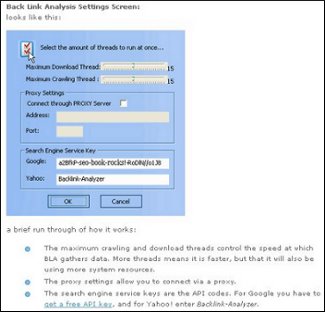 Here’s another cool thing you can do with your competitor’s website: back link analysis. SEO Book offers a free back link analyzer that you can download here. You enter simple information as you can see in the screen shot. When you run the program, set it up to acquire Google Rank and Alexa Rank for each back link. This is a matter of checking two boxes. The back link analyzer automatically filters out “rel=nofollow” links.
Here’s another cool thing you can do with your competitor’s website: back link analysis. SEO Book offers a free back link analyzer that you can download here. You enter simple information as you can see in the screen shot. When you run the program, set it up to acquire Google Rank and Alexa Rank for each back link. This is a matter of checking two boxes. The back link analyzer automatically filters out “rel=nofollow” links.
When you’re done, you can sort your results by PageRank and Alexa Rank. The reason for looking at both Alexa and PageRank is that each has its advantages and disadvantages. PageRank may be quirky due to whatever they’re penalizing recently, so you could miss out on a quality site because of its low PR. Alexa Rank is a measure of popularity, but doesn’t say anything about how Google views its quality. So use both as a system of checks and balances.
If you really want to delve into things, put your report data from the Back link analyzer into a spreadsheet. Make a copy where you sort the data by Google PR from highest to lowest. Then get rid of the ones that rank less than 4. Have another copy where you sort by Alexa Ranking from lowest to highest, and then do another sort by Google PR from highest to lowest. Get rid of the ones that have a negative Alexa Ranking. Congratulations: you now have lists of authority pages that link to your competitor.
So now that you have that data, what do you do with it? If you filter the links by domain, you can see how many links per domain the competitor is getting. If one website is repeated a lot, then you can bet that the competitor owns the website (or has bought a link from them). You can try running a “whois” on the domain, but you may not get a satisfactory answer.
Here’s another thing: if you see that a lot of the links are from the competitor’s own website, then chances are they have good content. If so, take note. You may need to focus on increasing your content or the quality of it.
Next you should figure out which of those links you’d like to get yourself. You can probably get several just by asking. It certainly can’t hurt (unless you accidentally ask for back links from sites that happen to be owned by the competitor, and even then, you might get a link).
In the midst of all this competitor sleuthing, don’t forget about your site. You’re doing this to learn, so be ready to apply some of what you find out to your own site, and hopefully you’ll get a boost in the rankings as well.
OK, let’s be honest right off the bat: most press releases received by most media organizations go right into the recycling bin. But that doesn’t mean yours will. For one thing, the good press releases have a few things in common, and for another, “media” now includes bloggers, ezines, streaming content producers, and freelancers. Whoever you plan to send press releases to, do some research on them first and make sure that your press releases would be a good fit for their organization. It’s the 21st century version of the old “don’t send a dog article to a cat magazine” rule.
 The press release is by no means dead, and is in fact very useful in many situations. Your press releases should be sent to news media for the purpose of letting the world know about company developments and newsworthy items. Concentrate on the word “newsworthy.” The number one reason journalists toss press releases is because they so often consist of self promotion dressed up to appear newsworthy.
The press release is by no means dead, and is in fact very useful in many situations. Your press releases should be sent to news media for the purpose of letting the world know about company developments and newsworthy items. Concentrate on the word “newsworthy.” The number one reason journalists toss press releases is because they so often consist of self promotion dressed up to appear newsworthy.
So really, the first thing you should ask yourself when you’re thinking about sending a press release is “Should I be sending a press release? Or is this just an exercise in vanity or wishful thinking?” Use the “so what” test, because this is what journalists and publishers do. If your press release says, “XYZ Widgetry, Inc. recently hired Dr. Joan Thingity to be head of their engineering development department,” the first thing the journalist is going to think is, you guessed it, “So what?”
Ah, but if your next sentence tells about how she won a MacArthur genius grant for her work on desktop plasma widgetry (or whatever) and that she was at one time part of NASA’s astronaut corps, then you’ve got an answer for the “So what” question. If your press release cannot answer the “So what” question, then don’t send it. Wait until you have something meaty.
While a successful press release ought to be newsworthy, you may have to make the tie-in to the news yourself. Journalists are busy enough that they’re not going to automatically realize that the release of your new phone app coincides with the latest iPhone release. You’ll have to spell it out.
Here are some ways to make sure that your press release is newsworthy and therefore less likely to be chucked in the recycle bin.
You get the idea.
You may wonder why you should bother at all with press releases, since they have such a high chance of disappearing into the gaping maw that is the editor’s office, never to be seen again. But it’s all a part of your overall marketing strategy. SEO has a place, plain old advertising has a place, and media relations has a place too. Once you do get a press release or two picked up, consider contacting the editor or reporters you have traction with and offer to send them exclusives. If they know that they’re the only game in town getting your press releases, they may just take you up on it. But none of this can happen without first mastering the press release. You’ll get nowhere unless you have correct grammar, spelling, and punctuation, plus the compelling writing necessary to stand out from the rest of the herd.
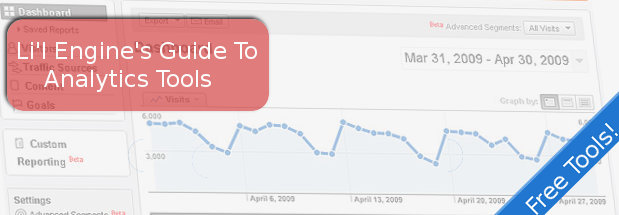
Whether you have a blog or a full-fledged e-commerce site, you probably are curious about how many people visit your site, which pages are most popular, how many page views you get, and how long visitors stay around. Fortunately, there are several free analytics programs you can get right online to help you dig into the numbers your website is generating and learn what stories those numbers tell. Four such programs are Onestatfree.com, Google Analytics, Piwik, and GoStats.
Onestatfree.com is a free subset of onestat.com, which provides web analytics for marketers and webmasters. The paid version starts at $125 per year and provides information on visitor behavior, conversions, and online advertising, plus a full range of website statistics software. Onestatfree is a hit counter that is password protected and has the ability to track an unlimited number of pages. It also gives you information about your visitors and your site for free. You can see an example of the information Onestatfree gives you on the first screen shot. To get Onestatfree, just go to onestatfree.com and register. You’ll be given a snippet of code to insert into your website’s source code that will start monitoring and analyzing visits to your site.
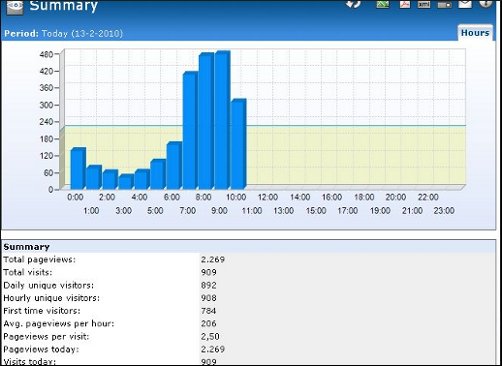
Onestatfree has a directory based on web statistics, and when you use the service, your website is automatically listed in the categorized charts based on web statistics. This is a way to easily see the most popular websites in each category based on Onestatfree statistics. Your site starts being listed as soon as the first visit is tracked by the counter. Categories of websites in the directory are: Arts, Business, Children, Computers & Internet, Culture & Religion, Education, Employment, Entertainment, Finance and Money, Games, Government, Health & Fitness, Hobbies & Interests, Home & Garden, Life & Family, Marketing, Movies & Television, Music & Radio, News & Media, Personal Homepages, Pets, Science & Technology, Society, Sports, Tourism & Travel, and Weblogs.
Google Analytics is perhaps the most famous of the free analytics packages. It gives you a broad range of information about your site, including advertising return on investment, cross-channel multimedia tracking (as you can see in the second screen shot), customizable reporting, and many ways to visually represent your site’s analytics. Using Google Analytics is also a matter of installing code into the source code of the website you want to track. Users of Google Analytics include some big names, like The American Cancer Society, Discount Tire, Yelp, Huffington Post, and RE/MAX Global Real Estate.

If you use Google AdWords, then you can integrate Google Analytics with it and review your online campaigns and track things like the quality of your landing page and your conversions. You define conversions as sales, lead generation, page views, or downloads. You can also use Google Analytics with Google AdWords to determine which ads perform best. You can identify poorly performing pages by looking at where your visitors come from (their referrers), and their geographical location. You can add up to 50 site profiles to Google Analytics, and each site must have traffic lower than 5 million pageviews per month, unless the site is tied to an AdWords campaign, in which case it can be bigger in terms of visitors.
Piwik is an open source, GPL licensed website analytic software program that is downloadable. Piwik gives you real-time reports on website visitors, including information like which keywords and search engines they used, what language they use, and which of your pages are most popular. Piwick calls itself the open source alternative to Google Analytics. It is a PHP MySQL program that you download and install. After the installation process, you get a JavaScript tag that you copy and paste into the source code of websites you want to track. An example of the type of reports you can get is shown in the third screen shot.

Piwik is constantly adding new features, like goal tracking, that can help you optimize your affiliate income if you participate in an affiliate program. Piwik 1.0, to be released in 2010, has already added some new features, like a one-click update check, new JavaScript tagging, and a dashboard to track multiple sites.
Gostats is another free hit counter that provides stats on not only the number of visitors to your site, but also information about page views, page popularity, and return visitors, as you can see on the fourth screen shot. Like the other free analytics software programs, you visit gostats.com, create an account, and copy and paste a small bit of code into your website’s source code. GoStats will then start tracking your site data. If you want more data than the free version of the software provides, you can upgrade to the professional version of GoStats. Another interesting page on the GoStats site is a huge chart comparing web hosting services in terms of price, how much disk space and bandwidth they provide, monthly cost, and initial setup cost. The three plans highlighted in green at the top of the chart are paid listings. You can narrow the chart down by specifying monthly costs or setup costs.
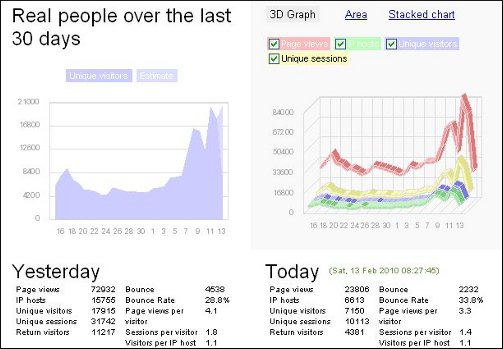
If you upgrade to GoStats Professional, you’ll get comprehensive site and data analysis, with regular reports and displays of visitor traffic on a map of the world.
Web analytics can be as simple or as complex as you want them to be. Whether you simply want the ego boost of knowing that your blog is being read, or whether you need lots of numbers crunched in order to maximize your site’s profitability, you can get that functionality easily. While Google Analytics is the leader of the pack, there are plenty of other options that you can try so you can find the analytics that are right for you.